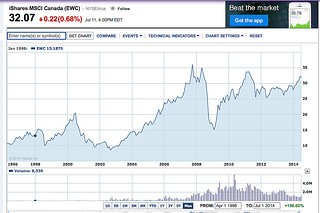Canadian ETFs The Easy Way to Invest Up North
Post on: 23 Май, 2015 No Comment

The Easy Way to Invest North of the Border
You can opt-out at any time.
Please refer to our privacy policy for contact information.
Canada is one of the most under-appreciated investment safe-havens in the world. With its large mining and energy sectors, the 10th wealthiest country in the world is one of the few net exporters of energy, while its high standard of living and per capita income make it very politically-stable. Investors seeking exposure to this rare combination may want to consider investing in Canadian ETFs.
Exchange-traded funds (ETFs) offer the diversity of an index with the simplicity of equity. Investors can invest in Canadian ETFs to gain exposure to the country’s entire economy, specific industries, or certain asset classes. These Canadian ETFs can be traded with a U.S. brokerage account like a normal equity, making them much easier than American Depository Receipts (ADRs) or buying foreign stock.
Top 10 Most Popular Canadian ETFs
Canadian ETFs have grown in popularity over the years, given the country’s stability and exposure to energy and commodities. From its gold mines to its oil sands to its logging industry, Canada may be best known for these assets, but its domestic services industry employs about three-quarters of its population. And the country is also one of the largest agricultural exporters in the world.
The most popular Canadian ETF with exposure to the country’s entire economy is the MSCI Canada Index Fund (NYSE: EWC ), which holds over 100 Canadian stocks with a total net asset value of nearly $5 billion. However, investors can also choose Canadian ETFs that focus on particular sectors or asset classes, as well as more general ETFs that tend to hold many Canadian stocks.
The five ETFs with the most Canadian exposure are:
- Canadian Energy Income ETF (NYSE: ENY )
- MSCI Canada Index Fund (NYSE: EWC )
- MSCI Canada Currency-Hedged Equity Fund (NYSE: DBCN )
- S&P/TSX Venture 30 Canada ETF (NYSE: TSXV )
- IQ Canada Small Cap ETF (NYSE: CNDA )
Five additional ETFs with more than 50% exposure include:
- Market Vectors Junior Gold Miners (NYSE: GDXJ )
- Gold Explorers ETF (NYSE: GLDX )
- Market Vectors TR Gold Miners (NYSE: GDX )
- Silver Miners ETF (NYSE: SIL )
- Uranium ETF (NYSE: URA )
The Benefits and Risks of Canadian ETFs
There are many benefits to investing in Canadian ETFs. The country is energy independent and ranks higher than the U.S. and most of the E.U. on the Heritage Foundation’s index of economic freedom. The country’s central bank also maintains a tight monetary policy that has helped its economy navigation global economic downturns with relatively little pain.
But, there are also many risks that investors should consider when investing in Canadian ETFs. The largest risk is the Canadian economy’s exposure to energy and commodities, which tend to be very volatile markets. While the secular trend may be upwards, slowing emerging market or global demand can quickly reverse these trends in the short and medium terms.
Alternatives to Investing in Canadian ETFs
Investors seeking more direct exposure to Canadian companies may want to consider American Depository Receipts (ADRs). These securities trade on U.S. stock exchanges and represent a specific number of shares in a foreign corporation. Unlike a Canadian ETF, these ADRs represent a single company instead of a basket of stocks.
Popular Canadian ADRs and U.S. traded stocks include:
- Bank of Montreal (NYSE: BMO )
- TELUS Corporation (NYSE: TU )
- Sun Life Financial Inc. (NYSE: SLF )
- BCE Inc. (NYSE: BCE )
- TransCanada Corporation (NYSE: TRP )
Alternatively, investors can also purchase foreign shares on the Toronto Stock Exchange (TSE) or the TSX Venture Exchange (TSX). Since Canada has strong ties to the U.S. many popular U.S. brokerages have the ability to make trades on these exchanges without significant extra legwork. However, there are some legal and tax implications that may apply.














